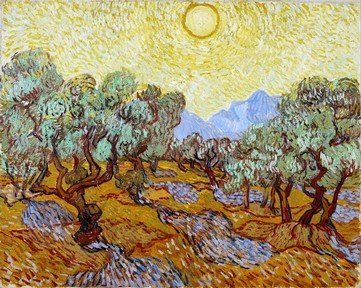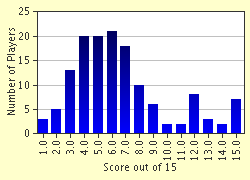Quiz Answer Key and Fun Facts
1. This well-known depiction of the Virgin and Child is painted in the Byzantine style and touchingly depicts the Christ child placing his hand in the Virgin's, while looking up at the archangel Gabriel holding aloft the cross. A persistent legend says that it was painted by the disciple and evangelist St. Luke, though it probably dates from no earlier than the 13th century. It was on display in Rome from about the 16th century and disappeared for a time during the Napoleonic Wars, but reappeared some forty years later. What is this painting's traditional title?
2. Giotto's painting of the Madonna and Child (c.1320-30) borrows certain characteristics of the Byzantine style, such as the gold background and dark-colored robes. Following the then-established tradition, he also depicts the Christ Child as a miniature, perfectly formed man with a mature expression; however he departs somewhat from tradition by having him playfully grasp his mother's finger (as infants are wont to do) as he reaches for something she is holding in her right hand; what is it?
3. The "Wilton Diptych" was painted around 1395 and was the personal property of an English monarch. The right-hand side of the diptych depicts the Virgin and Child against a gold background. The Virgin wears a brilliant blue mantle and veil and is surrounded by blue-clad angels with blue-grey wings tipped with black. The Christ child is wrapped in cloth of gold. The abundant blue and gold in this painting was created using costly lapis-lazuli and gold leaf. The left-hand panel depicts the painting's owner, who kneels in adoration of the Virgin and Child and is surrounded by his three patron saints. Which ill-fated English monarch was the owner of the Wilton Diptych?
4. Among the many paintings of the Madonna and Child by the 15th century Venetian artist Carlo Crivelli is one dated about 1480, now in the Metropolitan Museum of Art in New York City, in which the Christ child holds a goldfinch, making the painting a sort of predecessor to Raphael's "Madonna del Cardellino". The most noticeable feature in this painting, however, is not the goldfinch, but a far more unseemly creature who is perched on the marble ledge on which the Christ child sits and upon which the gaze of both mother and son are directed; what is it?
5. Choosing from among the many beautiful depictions of the Madonna and Child by Sandro Botticelli was not easy, but I have settled on the "Madonna of the Eucharist", painted c.1470 and currently owned by the Isabella Stewart Gardner Museum in Boston, Massachusets. The painting derives its title from the items presented by an angel to the Virgin and Child to be given their divine blessing; what items are these?
6. Several of Raphael's many depictions of the Madonna and Child, including the famous "Madonna della Sedia" ("Madonna of the Chair"), the "Madonna del Cardellino" ("Madonna of the Goldfinch") and his "Alba Madonna" depict the Virgin and Child in the company of this male saint, depicted as a child.
7. One of the most charming depictions of the Madonna and Child is by the 15-16th century French artist Gerard David in a painting dated about 1510. In this painting, the Virgin sits on a grassy mound with the Child in her lap and holds up a bunch of grapes for him to eat. Although at first glance this painting seems to be a typical "Madonna and Child", the presence of a donkey tied up nearby, of a basket at Mary's feet, and of Joseph in the background foraging for chestnuts tells us that this painting depicts a particular scene from the infancy of Christ; what is the painting's title?
8. A celebrated altarpiece painted in Germany c.1515 by a great German artist has a Madonna and Child as its central panel. The Virgin wears a rose-colored robe with a dark blue cape and holds the plump Christ child, who seems to be falling asleep, in her hands. To the left, a group of radiant angel musicians serenades the mother and son under an ornate canopy. At the Virgin's feet sit a humble child's bed and a laundry basket, contrasting with the splendor of the rest of the scene. The left and right panels of this altarpiece depict, respectively, the Annunciation and a Resurrection, in which a radiant-faced Christ seems to literally float up from the tomb. The back of the altarpiece depicts SS. Paul and Antony in the desert and includes the Temptation of St. Antony. The altarpiece is perhaps best known, however, for the vividly gruesome depiction of the Crucifixion painted on the front doors. Which of these celebrated altarpieces is it?
9. Leonardo da Vinci's sketch for his celebrated painting "Madonna and Child with St. Anne" is almost as well-known as the finished painting. Several changes were made before da Vinci completed the oil painting, which now hangs in the Louvre; which of these was NOT one of them?
10. The great Michelangelo gave us several renditions of the Madonna and Child in sculpture and bas-relief. Among these are the Bruges Madonna (a sculpture; the head of the Virgin is strikingly similar to that in the "Pieta"), the Pitti Madonna and the Madonna de la Scala (both bas-reliefs) and the Medici Madonna. The latter is actually a set of three sculptures, the central one being the Madonna and Child who are flanked by these two early Christian martyrs, who are the patron saints of physicians.
11. Francesco de Zurbaran's "Christ and the Virgin in the House at Nazareth" (c.1630) is a rare depiction of the Virgin with the older Christ child. In this painting, Christ appears to be about nine or ten years old and sits across the room from his mother. Mary observes, with a look of intense pity and sadness, that he has injured himself; what has he been doing?
12. The 1819 painting entitled "The Virgin of the Harvest" is significant in that it is the first important painting by this great 19th century French artist.
13. This 1891 painting depicts the Virgin as a young Tahitian woman wearing a red dress imprinted with white flowers, carrying the sleeping child on her shoulder. She stands amid flowering bushes and is being venerated by two other native women and by an angel who is partly hidden behind one of the bushes. The title of the painting is "La Orana Maria" ("Hail Mary"). Which of these 19th century French artists created this painting?
14. Between 1948 and 1951, French artist Henri Matisse devoted himself to the decoration of the Dominican convent chapel at Vence. This remarkable achievement included designing the stained glass windows, the vestments and tabernacle, and the painting of three large murals, depicting St. Dominic, the Madonna and Child, and the Stations of the Cross. What is unusual about Matisse's painting of the Madonna and Child?
15. Salvador Dali's 1950 painting "The Madonna of Port Lligat" is a typical example of the artist's religious art, which includes an "Assumption", two Crucifixions, a "Temptation of St. Antony", and a "Last Supper". The Virgin sits enthroned with Christ on her lap under a (typically) fractured stone arch poised in midair above an altar. Among the numerous striking, and somewhat bizarre images in this work (which includes a rhinoceros) is a sort of window cut, as it were, in the center of both the Virgin and Christ child's bodies through which an object can be seen; what is the object?
Source: Author
jouen58
This quiz was reviewed by FunTrivia editor
agony before going online.
Any errors found in FunTrivia content are routinely corrected through our feedback system.

